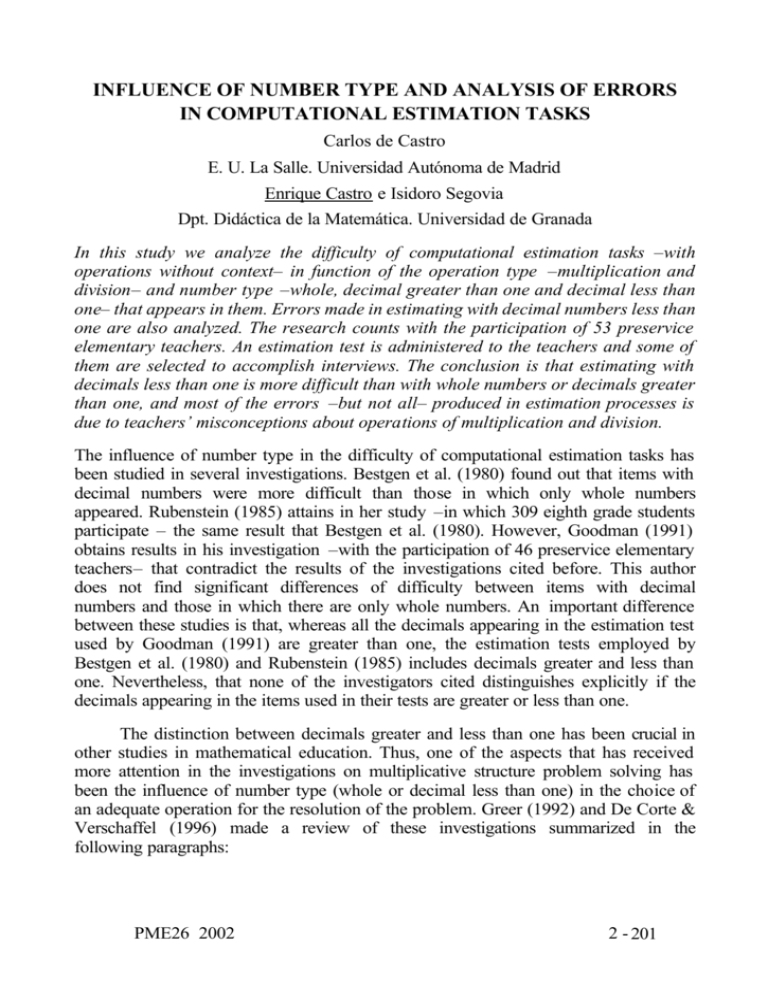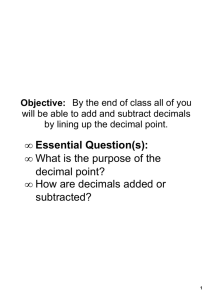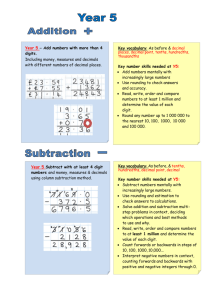influence of number type and analysis of errors in computational
advertisement

INFLUENCE OF NUMBER TYPE AND ANALYSIS OF ERRORS IN COMPUTATIONAL ESTIMATION TASKS Carlos de Castro E. U. La Salle. Universidad Autónoma de Madrid Enrique Castro e Isidoro Segovia Dpt. Didáctica de la Matemática. Universidad de Granada In this study we analyze the difficulty of computational estimation tasks –with operations without context– in function of the operation type –multiplication and division– and number type –whole, decimal greater than one and decimal less than one– that appears in them. Errors made in estimating with decimal numbers less than one are also analyzed. The research counts with the participation of 53 preservice elementary teachers. An estimation test is administered to the teachers and some of them are selected to accomplish interviews. The conclusion is that estimating with decimals less than one is more difficult than with whole numbers or decimals greater than one, and most of the errors –but not all– produced in estimation processes is due to teachers’ misconceptions about operations of multiplication and division. The influence of number type in the difficulty of computational estimation tasks has been studied in several investigations. Bestgen et al. (1980) found out that items with decimal numbers were more difficult than those in which only whole numbers appeared. Rubenstein (1985) attains in her study –in which 309 eighth grade students participate – the same result that Bestgen et al. (1980). However, Goodman (1991) obtains results in his investigation –with the participation of 46 preservice elementary teachers– that contradict the results of the investigations cited before. This author does not find significant differences of difficulty between items with decimal numbers and those in which there are only whole numbers. An important difference between these studies is that, whereas all the decimals appearing in the estimation test used by Goodman (1991) are greater than one, the estimation tests employed by Bestgen et al. (1980) and Rubenstein (1985) includes decimals greater and less than one. Nevertheless, that none of the investigators cited distinguishes explicitly if the decimals appearing in the items used in their tests are greater or less than one. The distinction between decimals greater and less than one has been crucial in other studies in mathematical education. Thus, one of the aspects that has received more attention in the investigations on multiplicative structure problem solving has been the influence of number type (whole or decimal less than one) in the choice of an adequate operation for the resolution of the problem. Greer (1992) and De Corte & Verschaffel (1996) made a review of these investigations summarized in the following paragraphs: PME26 2002 2 - 201 a) Children have difficulties in the choice of the appropriate operation for solving multiplicative verbal problems with decimal numbers less than one. b) These difficulties are due to children’ misconceptions about the effect of multiplying or dividing by decimal numbers less than one. Many children believe that "multiplication always makes bigger", "division always makes smaller" and "we always divide a large number by a smaller number". These ideas, valid for certain types of numbers (whole numbers), do not work when they are extrapolated to decimal numbers less than one. c) Misconceptions in multiplication and division are originated by the predominance in the teaching of operations of the repeated addition model for multiplication and the partitive model of division. In the interpretation of multiplication as repeated addition, the multiplier should be a whole number and the product greater than the multiplicand. On the other hand, if division is interpreted as “sharing out”, the divisor should be a whole number and the divisor and the quotient less than the dividend. These results have also been found in studies with preservice elementary teachers. Tirosh and Graeber (1989) detected that 10% of the teachers held explicitly that "multiplication makes bigger", whereas almost the majority (more than 50%) of the teachers held explicitly that in a division problem, the result should be less than the dividend. In the case of multiplication, the belief "multiplication makes bigger" is implicit for a majority. It appears in the solutions that students give to the problems but it is not maintained explicitly. Students show a very strong dependency on the operations with whole numbers and their procedural knowledge of the operations. They have also a strong dependency on the repeated addition model for multiplication and the partitive model of division. On the other hand, Levine (1980) and Morgan (1990) have also found difficulties in estimation tasks with decimal numbers less than one. Both authors attribute these difficulties to the presence of misconceptions about the operations. According to all these antecedents, the hypothesis outlined in this work is that the real difference of difficulty in computational estimation tasks appears when items with whole numbers or decimals greater than one are compared with those with decimal numbers less than one. Thus, the main objective of this study is to analyze the relative difficulty of computational estimation tasks –with operations without context– depending on the operation type –multiplication and division– and the number type –whole, decimals greater than one, and decimals less than one– that appears in them. Another objective is to analyze teachers’ errors in estimating the results of operations with decimal numbers less than one. In this paper the term “error” is considered in a broad sense as a lacking and incomplete knowledge. For example, misconceptions about the operations –as the belief "multiplication always makes bigger"– reflect a knowledge that has a certain validity domain –operations with whole numbers– but constitute an error when it is attempted its extrapolation to 2 - 202 PME26 2002 operations with decimals less than one. The analysis of errors performed in this study has the purpose of determining if all the errors produced in the estimation processes –in tasks with decimals less than one– have their origin in misconceptions about the operations or if, on the contrary, there are other types of characteristic errors in these estimation tasks. METHOD Two independent variables have been considered: "operation type" –multiplication and division– and "number type" –whole, decimal greater than one, and decimal less than one–. The dependent variable is the score obtained by a subject when performing an estimate. When an estimation is performed, we can calculate its percentage of error. If it is greater than 30%, zero points are scored; if it is greater than 20% but no more than 30%, one point is scored; if it is greater than 10% but no more than 20%, two points are scored; and if the percent of error is no more than 10%, three points are scored. Furthermore, some variables have been controlled: considering the format of the questions, the test is constituted by estimation items with direct –not applied– computations; all the computations have been presented in horizontal format; and finally, only opened response items have been used. Subjects The research has counted with the participation of 53 preservice elementary teachers of different first course specialties of the Escuela Universitaria La Salle, assigned to the Universidad Autónoma de Madrid. The ages of the participants were from 18 to 24 years. Ten subjects were selected from this sample to accomplish –through an interview– the analysis of errors in computational estimation. All the students participated in a period of instruction about computational estimation of ten hours, during which they received explicit teaching about estimation strategies. Estimation was also practiced in both direct and applied computations. At the end of the period of instruction, the participants realized the estimation test. Instruments and application The Test of Estimation Ability (Levine, 1980) was administered to the students. This test consists on estimating mentally the results of ten multiplications and ten divisions. Items are of three types: (a) operations with whole numbers, (b) operations with a decimal number greater than one, and (c) operations with a decimal number less than one. Numbers in the test have zero, one, or two decimal digits. Furthermore, no number has more than five digits in total. The test was administered in the computer science classroom during a period of class using PCs. The participants came into the classroom without carrying anything with them. These limitations were established to avoid the students’ usage of any computational procedure that was not mental. There was no direct limitation of the response time for each item or for the whole the test. However, the students received indications to realize their estimates briefly. PME26 2002 2 - 203 The results of the estimation test have also been used to select subjects for the phase of the study of error analysis, realized through an interview. The subjects were requested for giving an estimate for a proposed calculation and then, they explained the procedure used to produce their estimate. In the interview we used the items from the test of Levine (1980) with decimal numbers less than one (187.5 × 0.06; 64.5 × 0.16; 424 × 0.76; 0.47 × 0.26; 66 ÷ 0.86; 943 ÷ 0.48; 0.76 ÷ 0.89). The subjects selected for the interview were those whose estimates –for the cited items– were all compatible (or all incompatible) with an adequate knowledge of the relative effect of operations. For example, an estimation for 187.5 × 0.06 fulfils this condition if it is within the interval (0.06, 187.5). In other words, if the student does not incur in misconceptions as: "multiplication always makes bigger" or "division always makes smaller". The interviews have been done individually. They were registered using a recorder and transcribed for their subsequent analysis. RESULTS To study the possible effect of the independent variables in the dependent variable, a factorial design of two factors, with repeated measures in both factors has been accomplished. The factor “operation type” has two levels: multiplication and division; and the “number type” has three levels: whole numbers, decimals greater than one, and decimals less than one. The statistical analysis has been performed with the Statistical Package for the Social Sciences (SPSS) for Windows (version 9.0.1). Table 1 gives the mean scores and the standard deviations for the estimation test. Table 1. Mean scores and standard deviations for estimation test Operation type Multiplication Division Number type Whole Decimal greater than one Decimal less than one Operation type × Number type Multiplication Whole Decimal greater than one Decimal less than one Division Whole Decimal greater than one Decimal less than one Mean SD 1.236 1.121 0.097 0.079 1.448 1.261 0.825 0.083 0.122 0.087 1.453 1.547 0.708 1.443 0.975 0.943 0.107 0.152 0.095 0.107 0.134 0.113 Results of the analysis of variance There are statistically significant effects for the factor "type of number" (F = 20.056, p = 0.000) and for the interaction between the factors "type of operation" and "type of number" (F = 8.895, p = 0.000). On the contrary, there is no statistically significant effect for the factor "type of operation". 2 - 204 PME26 2002 In order to know between which levels of the factor "type of number" the significant differences have been produced, we have used the test T with the Dunn– Bonferroni correction. We have been found statistically significant differences between level 3 –decimals less than one– and level 1 –whole numbers– (T = 7.090, p = 0.000) and between level 3 and level 2 –decimals greater than one– (T = 3.991, p = 0.001). However, there is no significant difference between the mean scores corresponding to levels 1 and 2 of the factor. In spite of the fact that the mean scores for multiplication and division items are very similar, the study of the interaction allows to clarify that this equality is not maintained through all levels of the factor "number type". Table 1 gives the mean scores corresponding to all the combinations of levels of the factors in the design. We can observe in this table that the mean score for multiplication is much greater than for division when decimal numbers greater than one are operated, and smaller when decimals less than one appear. As we have seen before, the interaction between operation type and number type has a significant effect in the scores. To determine between which combinations of levels these significant differences have been produced, we have accomplished the within-subjects contrast test –simple contrasts option –. There is a significant interaction for levels 1 and 2 of the factor 1 and levels 1 and 2 of the factor 2 (F = 9.463, p = 0.003). The other significant interaction is given between levels 1 and 2 of the factor 1 and levels 2 and 3 of the factor 2 (F = 16.739, p = 0.000). Results of the analysis of errors To accomplish the error analysis we have used the diagrams for the description of estimation strategies proposed by Segovia, E. Castro, Rico and E. Castro (1989). The errors have been classified attending to the estimation processes –identified by Reys, Bestgen, Rybolt and Wyatt (1982)– in which they have been produced. Thus, errors may be found in reformulation, translation, and compensation processes. Within some strategies, errors have been detected in the process of reformulation. We can find among them the following example: Interviewer: 187.5 × 0.06 Subject: 1.2. I have rounded the first to 200, multiplied by 6 and then I have put the three decimals. Computational estimation problem (CEP) → Reformulation → Computation 187.5 × 0.06 → (200 × 6) ÷ 1000 → 1.2 In this case the subject has reformulated the initial problem rounding one of the numbers. In this reformulation, an error has been produced. In fact, the subject operates decimal numbers as if they were whole numbers, ignoring the decimal points. Afterwards, he puts as many decimals on the result as there are in total in the multiplied numbers. However, the rounding of 187.5 (substituting this number in the calculation by 200) supposes the loss of a decimal figure, so that 187.5 × 0.06 should PME26 2002 2 - 205 have been substituted in the reformulation by (200 × 6) ÷ 100 = 12. These errors in reformulation are caused by an inadequate combination of the rules of operating decimal numbers with the rules of rounding. In other strategies, errors appear as a consequence of the application of students misconceptions about the operations with decimals and, particularly, due to an inadequate knowledge of the effect of multiplying or dividing a number by a decimal less than one. An example of this situation is the following fragment of the interview: Interviewer: 943 ÷ 0.48 Subject: And that [pointing to 943] [divided] by half. Or [multiplied] by a half. 943, the half… and then… Four hundred and fifty something. CEP → Reformulation → Translation → Translation → Reformulation → Computation 943 ÷ 0.48→ 943 ÷ ½ → 943 × ½ → 943 ÷ 2 → 900 ÷ 2 → 450 The subject decides to substitute 0.48 by 1/2. This substitution leads to a translation process (where the division is changed by a multiplication). In this first translation process the error is found. This error is caused by the mixture of the misconception "division always makes smaller" with the substitution of 0.48 by ½, and the interpretation of ½ as "making the half". Finally, in the following examples, errors are located in the intermediate compensation or in the final compensation. Interviewer: 424 × 0.76 Subject: 400. I have rounded down, 400, and this [pointing to 0.76] up, by 1. CEP → Reformulation + Intermediate compensation → Computation 424 × 0.76 → 400 × 1 → 400 Here, the subject has employed the substitution by "powers of ten" changing 0.76 by 1 and, after, but previous to the calculation, he has been attempted to compensate that first substitution changing 424 by 400. This intermediate compensation has had an adequate direction but not enough “intensity”. The same circumstance has occurred in the following example. The only difference is that the compensation in this case is accomplished at the end of the process (after the calculation). Interviewer: 424 × 0.76 Student: That [Pointing to 0.76]... [Rounded] to 1. Well, it would be a little less than 424, 420. CEP → Reformulation → Computation → Final compensation 424 × 0.76 → 424 × 1 → 424 → 420 As in the previous case, the size of the compensation is too small. It has been observed that sometimes, if the student does not know a better criterion –as would be in this case the use of the distributive property–, an intuitive compensation is 2 - 206 PME26 2002 effectuated. Many times, this intuitive compensation consists simply in a rounding in the adequate direction (as 424 rounded to 420). In the following estimation, a final compensation has been accomplished with an error in its direction. It has been used as an approximation skill the substitution by a power of 10. Interviewer: 66 ÷ 0.86 Subject: I would divide this [pointing to 66] by one. Well, but then I would subtract from it a little. It would be 60. CEP → Reformulation → Computation → Final compensation 66 ÷ 0.86 → 66 ÷ 1 → 66 → 60 CONCLUSIONS As we have seen in the review of literature about the problem, there was a disagreement between the results obtained in the studies of Bestgen et al. (1980) and Rubenstein (1985), and those of Goodman (1991) with respect to the relative difficulty of the computational estimation tasks depending on the number type. In the first two studies the authors arrived to the conclusion that it was more difficult estimating with decimals than with whole numbers. However, in the study of Goodman (1991), there were no significant differences of difficulty between these two types of items. This contradiction guided the elaboration of the main hypothesis of this research, after proving that in the study of Goodman (1991) –to the opposite that in the others– items with decimal numbers less than one did not appear in the estimation test. In this paper, items with decimal numbers less than one have been more difficult than those with whole numbers or decimals greater than one. This circumstance can explain the apparent contradiction derived from the results of Bestgen et al. (1980), Rubenstein (1985), and Goodman (1991). In this research it has been crucial to make the distinction between the decimals greater than one and less than one. This distinction had not been made in the studies cited before and allows relating the results found in this work with the ones originated from other research fields in mathematical education. For example, as we have been seen in the introduction, in the field of problem solving, it has been found that there are students with misconceptions about multiplication and division that emerge when decimals less than one appear. The difficulty of the estimation tasks as well as the difficulty in choosing the appropriate operation for solving a problem seem to be different demonstrations of these misconceptions. Misconceptions in the operations are also responsible for some of the errors produced in the estimation processes. Within this type of errors, there are those produced by giving an improper direction to the compensations and other errors in the translation processes –as the substitution of "dividing by 2" by "making the half"–. These types of errors had been already described by Levine (1980). However, the error found in the processes of reformulation –absence of coordination of PME26 2002 2 - 207 rounding with the adjustment of the decimal point– had not been described before. It is a characteristic error in estimation processes that is not originated by misconceptions in the operations. Consequently, we think that it will be necessary to accomplish –in a future research– a more detailed analysis of students’ errors in making estimations. This type of analysis can facilitate the determination of the factors that, together with the misconceptions on the operations, influence in the greater difficulty of the computational estimation tasks with decimal numbers less than one. REFERENCES Bestgen, B., Reys, R., Rybolt, J., & Wyatt, J. W. (1980). Effectiveness of systematic instruction on attitudes and computational estimation skills of preservice elementary teachers. Journal for Research in Mathematics Education, 11, 124-136. De Corte, E., & Verschaffel, L. (1996). An empirical test of the impact of primitive intuitive models of operations on solving word problems with a multiplicative structure. Learning and Instruction, 6, 219-243. Greer, B. (1992). Multiplication and division as models of situations. In D. A. Grouws (Ed.), Handbook of research on mathematics teaching and learning (pp. 276-295). New York: Macmillan Publishing Company. Goodman, T. (1991). Computational estimation skills of pre-service elementary teachers. International Journal of Mathematical Education in Science and Technology, 22, 259-272. Levine, D. R. (1980). Computational estimation ability and the use of estimation strategies among college students. Doctoral dissertation. New York University. Morgan, C. (1990). Factors affecting children’s strategies and success in estimation. In G. Booker, P. Cobb, & T. N. de Mendicuti (Eds.), Proceedings of the Fourteenth Psychology of Mathematics Education Conference (pp. 265-272). Mexico. Reys, R. E., Bestgen, B. J., Rybolt, J., & Wyatt, J. (1982). Processes used by good computational estimators. Journal for Research in Mathematics Education, 12, 183-201. Rubenstein, R. (1985). Computational estimation and related mathematical skills. Journal for Research in Mathematics Education, 16, 106-119. Segovia, I., Castro, E., Castro, E., & Rico, L. (1989). Estimación en cálculo y medida [Computational and measurement estimation]. Madrid: Síntesis. Tirosh, D., & Graeber, A. O. (1989). Preservice elementary teachers’ explicit beliefs about multiplication and division. Educational Studies in Mathematics, 20, 79-96. 2 - 208 PME26 2002





